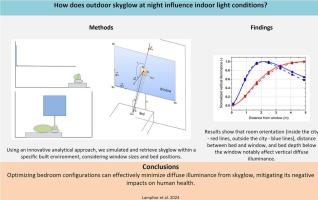Computed indoor light conditions due to outdoor skyglow at night
IF 6.9
2区 工程技术
Q1 ENVIRONMENTAL SCIENCES
引用次数: 0
Abstract
Light pollution poses a significant challenge in the built environment, negatively impacting human health. One key aspect is light trespass, where light extends beyond its intended target, such as windows, causing annoyance, disrupted sleep patterns, and a diminished quality of life for residents. While shielded outdoor lighting can address direct light trespass, mitigating light trespass from skyglow presents complexities due to its unshieldable nature. This study explores the impact of skyglow-induced light trespass on indoor environments, aiming to develop a tool for quantifying its effects on human health in future studies. Using an innovative analytical approach, we simulated and measured skyglow within a specific built environment, considering window sizes and bed positions. Results indicate that room orientation, bed-window separation distance, and bed depth below the window significantly influence vertical diffuse illuminance. Surprisingly, the maximum illuminance occurs at a specific depth within the room, influenced by the interaction between window solid angle and sky segment brightness. Optimizing bedroom configurations can effectively minimize diffuse illuminance from skyglow, mitigating its negative impacts on human health. Importantly, this effect varies significantly when transitioning from urban city edges to suburban areas.

计算夜间室外天光导致的室内光照条件
光污染对建筑环境构成重大挑战,对人类健康产生负面影响。一个关键的方面是光线的侵入,光线超出了预定的目标,如窗户,引起烦恼,扰乱睡眠模式,降低居民的生活质量。虽然屏蔽户外照明可以解决直接的光线侵入,但由于其不可屏蔽的性质,减轻天光的光线侵入呈现出复杂性。本研究探讨了天光诱导的光侵入对室内环境的影响,旨在为未来的研究开发一种量化其对人体健康影响的工具。使用创新的分析方法,我们模拟和测量了特定建筑环境中的天光,考虑了窗户的大小和床的位置。结果表明,房间朝向、床窗间距和床窗深度对垂直漫射照度有显著影响。令人惊讶的是,最大照度出现在房间内的特定深度,受窗户立体角和天空段亮度之间相互作用的影响。优化卧室配置可以有效地减少天光的漫射照度,减轻其对人体健康的负面影响。重要的是,当从城市边缘向郊区过渡时,这种效应会发生显著变化。
本文章由计算机程序翻译,如有差异,请以英文原文为准。
求助全文
约1分钟内获得全文
求助全文
来源期刊

Urban Climate
Social Sciences-Urban Studies
CiteScore
9.70
自引率
9.40%
发文量
286
期刊介绍:
Urban Climate serves the scientific and decision making communities with the publication of research on theory, science and applications relevant to understanding urban climatic conditions and change in relation to their geography and to demographic, socioeconomic, institutional, technological and environmental dynamics and global change. Targeted towards both disciplinary and interdisciplinary audiences, this journal publishes original research papers, comprehensive review articles, book reviews, and short communications on topics including, but not limited to, the following:
Urban meteorology and climate[...]
Urban environmental pollution[...]
Adaptation to global change[...]
Urban economic and social issues[...]
Research Approaches[...]
 求助内容:
求助内容: 应助结果提醒方式:
应助结果提醒方式:


